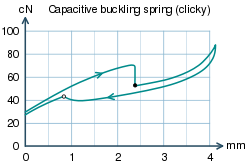Hysteresis
This article is a stub. You can help Deskthority by expanding it.

In keyboard terminology, hysteresis refers to when a switch's release point is higher than its actuation point. For example, an IBM capacitive buckling spring switch, with 4.2 mm travel, will actuate when the slider is depressed by 2.4 mm, but will not release until the slider is back to 0.8 mm of the home position.
A degree of hysteresis is a desirable characteristic that not all switches possess. Excessive hysteresis will make tapping the same key twice in succession difficult, which will pose an issue for gamers engaged in high speed games that require tapping a single key repeatedly.
Hysteresis is an inherent property of stacked spring designs, as well as spring over dome designs such as Fujitsu Peerless.
Terminology
Cherry refer to the hysteresis in clicky Cherry MX switches as "movement differential" and "differential movement" in their catalogues and in the patent for Cherry MX. The audible click sound generated by the mechanism in question is not mentioned in the patent.
Another common term, found in patents, is "lost motion", referring to the backlash-like behaviour of hysteresis. The patent for Datanetics DC-50 series for example notes that an "actuating spring is coupled to the side of the keystem by a lot-motion [sic] connection which provides hysteresis in the key action". Burroughs patent US4034177 describes a switch that "uses a lost motion mechanism to prevent the switch from making and breaking contact more than once for each plunger depression".